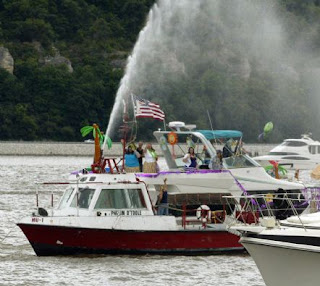Church
bells were the original station siren or pager of the day. Such an alarm did not only bring out the
engine men, but the community as a whole with their buckets. Early truck work was aggressive and took the
form of sometimes tearing down neighboring homes or buildings with their hooks
to contain the fire and limit spread, the trench cut of the 1700s.
In
Boston, Revolutionary leaders such as Sam Adams and John Hancock were firewards
(equivalent to a modern day Captain) and helped organize their companies as
part of the resistance to the British.
Other firewards were participants in and gave aid in Paul Revere’s
ride. In some cities, fire companies
adopted resolutions stating they would not fight a fire, should one occur, in
the hated Tax Stamp office unless other property was endangered. The Sons of Liberty, a Revolutionary era
political organization with an anti-British focus drew a significant percentage
of its membership from the ranks of the firemen in many cities. That is not to say that firemen universally
supported the Revolution any more than all firefighters today subscribe to a
particular ideology. Firemen then supervised
actual political fires including effigy burnings and those of Tax Stamps. Historians argue that fire companies provided
a model and much manpower for Revolutionary ideals and organizations. Many fought as part of the Continental Army
and cities had difficulty maintaining their companies and engines. As the towns and cities sprung up, so did the
need for fire companies.
Franklin
wrote about the reasons men volunteered in their communities. They did it “not for the sake of reward money
or fame. There is no provision of either
made for them. But they have a reward in
themselves, and they love one another.”
Altruistic reasons aside, some things haven’t changed as the fire
companies of the Revolutionary era enjoyed “a vibrant social life.”
While
it may seem simplistic, the development of American cities with the density of
housing and other buildings as well as vertical expansion with taller buildings
simply could not have happened without fire departments. Today, fire departments are viewed by many as
simply another public agency for which municipal budgets and taxes struggle to
support. In the era of the Revolution,
they were truly part of the foundation without which the country could not have
survived.
























.jpg)






